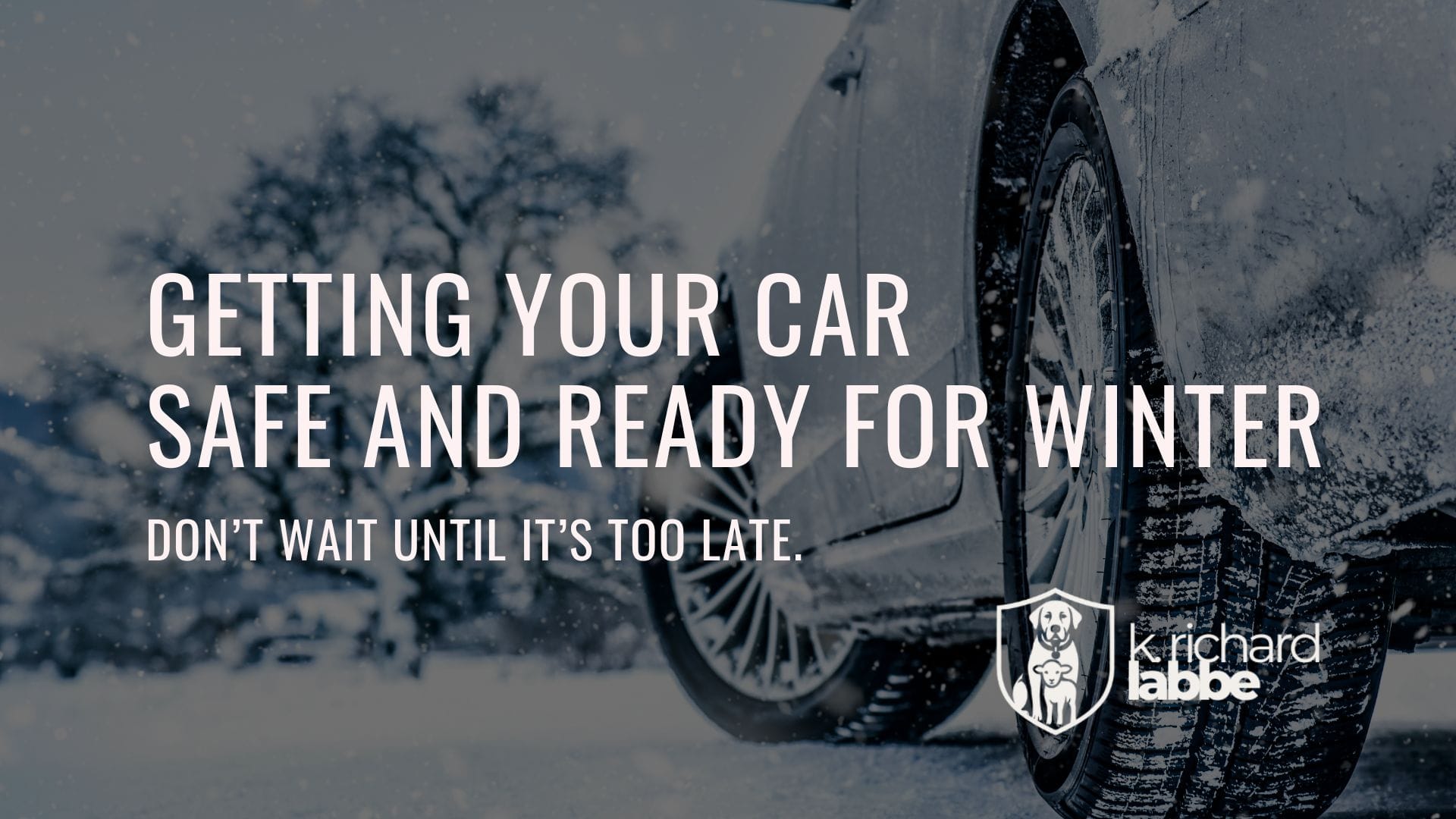Be Ready: Getting Your Car—and Your Family—Through Winter Safely
A little preparation this fall can keep you and your family safe on the roads this winter.

Picture this: It's 6 AM on a Tuesday in January. You're running late for work, scraping ice off your windshield in the dark, when your car decides it's had enough. The engine won't turn over. Your phone shows 15% battery. And that weather app you ignored yesterday? Yeah, it's now calling for three more inches of snow.
Winter doesn't negotiate. It doesn't care that you're unprepared or in a rush. Thankfully, a little preparation now can turn a potential disaster into just another story you'll tell later, but you need to act now.
Your Car: The Foundation of Winter Safety
Think of winter prep like insurance: boring to research, invaluable when you need it. Start with these essentials that could save your life (and your sanity):
Battery Power
Cold weather cuts battery strength in half, sometimes even more. If your battery struggled to start the car even once last winter, don't gamble on this one. Get it tested at any auto parts store (usually free) or during your next oil change. If it's weak, replace it. If the terminals are corroded, clean them.
Tire Check
The penny test still works: stick Lincoln's head into your tire tread. If you can see anything close to the top of his head, your tires are toast – especially for winter conditions. Check tire pressure monthly, too. Cold air deflates tires, and under-inflated tires are accidents waiting to happen. Consider moving from all-weather to winter tires for the season. In snow-heavy regions, winter tires – even tire chains – aren't a luxury; they're survival gear.
Fluid Fundamentals
Switch to winter-grade windshield washer fluid (the summer stuff will freeze solid). Keep antifreeze clean and topped off, also changing your oil on schedule. Toss an extra jug of washer fluid in your trunk. You'll burn through it faster than you think.
Visibility Essentials
Replace old windshield wipers before the first storm. Test every light: headlights, taillights, turn signals, hazards. In winter, being seen can be as critical as seeing.
The Half-Tank Rule
Consider half a tank as empty in winter. Keeping your tank at least half full gives you options if you're stranded.
Smart Choices: When Not to Drive
The most dangerous trip is the one you don't need to take. Monitor weather forecasts, especially if you or family members travel during peak storm times. Early morning or late evening commutes can turn deadly fast.
When you must travel: Leave extra time and tell someone your route and expected arrival. Stick to main roads (they're typically plowed and treated first), double your following distance, and slow down more than feels necessary. Maintaining safe distance and slowing down are two of the most important things you can do as a safe driver, especially in inclement weather.
Bridge Warning
Bridges and overpasses freeze first because cold air circulates above and below the roadway. Even without visible precipitation, a nearly invisible sheet of ice can form. Approach with caution and avoid sudden movements with your steering wheel, brakes, or accelerator.
Stranded but Not Helpless
Getting stuck requires you to stay calm and follow some key principles:
Stay Put
Your car is shelter, warmth, and visibility. Don't abandon it to walk for help unless you can literally see your destination and have a safe path to get to it. Otherwise, if you're safely parked, call for help instead.
Value Life Over Property
If your car is disabled on a high-speed highway, it may be safer to move behind a guardrail after calling for help. Every situation is different—prioritize life over property and use your best judgment.
Engine and Fuel Management
If you're running low on fuel, run your engine for about 10 minutes each hour for warmth. Crack a window slightly to prevent carbon monoxide buildup, and always check your exhaust pipe—snow can block it, turning your refuge into a death trap. Remember: carbon monoxide is an odorless gas, a silent killer if you're not careful.
Stay Visible
Deploy your hazard lights, reflective triangles, flares, and a high-visibility vest from your emergency kit. Tie a bright cloth to your antenna. Make yourself impossible to miss.
Body Heat Basics
Layer up with blankets and extra clothing. Keep socks and gloves dry; wet extremities accelerate hypothermia. Watch for frostbite warning signs on fingers, toes, and ears.
Stay Connected While Conserving Power
Don't drain your phone using it as a flashlight. Carry a real flashlight and power bank for recharging. In remote areas, consider an emergency radio or satellite communicator.
Remember: panic can be as dangerous as the cold. Take a breath. Stay calm. Clear thinking saves lives.
The Good Samaritan Trap
The instinct to help stranded motorists is admirable. Unfortunately, it can also be deadly, perhaps especially in winter.
Standing near a disabled car on ice puts you directly in harm's way. Other drivers may lose control and slide into the shoulder where you're standing. Every winter brings tragic stories of well-meaning helpers who become victims themselves.
Here is a better approach: Call for professional help (police, tow service, AAA) from a safe location. If you must stop to do so, pull far off the road, turn on flashers, and stay inside your vehicle until conditions are genuinely safe.
Sometimes protecting life means resisting the heroic urge.
Sign Up for a Roadside Service
When your car dies on a winter shoulder at midnight, that's not the time to discover you're on your own. Quality roadside assistance—like AAA membership—can mean the difference between rescue and real danger.
AAA delivers 24/7 roadside services including towing, jump starts, tire changes, lockout assistance, and emergency fuel delivery (AAA). Your membership travels with you, meaning coverage even as a passenger in someone else's car.
Additionally, AAA services won't count as a claim on your auto insurance policy (AAA). Unfortunately, many drivers report that using insurance-based roadside assistance does count as a claim and could raise premiums.
Parents with Young Children
Here's a safety tip many parents miss: bulky winter coats can compromise car seat effectiveness. Heavy coats can compress in a crash, creating dangerous slack in the harness (NHTSA). Consumer Reports confirms that extra room from winter coats reduces restraint effectiveness.
The Mayo Clinic recommends dressing children in thin, warm layers, securing them snugly in car seats, then covering with blankets (Mayo Clinic Community Health).
We also advise parents and guardians traveling with young children to travel with extra snacks and drinks, diapers, wipes, comfort toys for delays, and the mental preparation to add two hours to any winter trip.
Families With Pets
Pack leashes, water bowls, food, and pet blankets. Use harnesses or crates; sudden stops on ice can seriously injure unrestrained animals. Never leave pets alone in cold vehicles, even briefly.
A Helpful Checklist: Your Winter Survival Kit
Keep these items in your trunk or cargo area from November through March.
NOTE: These are affiliate links. If you make a purchase through these links, we may receive a small commission at no extra cost to you. Thank you for supporting our work in this way!
- Snow brush and ice scraper
- Jumper cables or portable jump starter
- Collapsible shovel
- Kitty litter or sand (for traction)
- Tow strap
- Flashlight with extra batteries (make sure to get the right size)
- Reflective triangles, road flares, high-visibility vest
- Blankets or sleeping bags
- Hand warmers
- Extra hats, gloves, socks, waterproof boots
- Non-perishable snacks and bottled water
- Phone charger (make sure to get the right connection)/power bank
- First aid kit
- Multi-tool or basic toolkit
- Duct tape
- Tire chains or traction socks (where required)
- Extra windshield washer fluid (for winter)
- "Slime" for emergency flat tire repair
- Portable air pump for tires
- Waterproof pouch with registration, insurance, emergency contacts
The Bottom Line
Winter driving isn't about conquering the elements, but respecting them. With thoughtful preparation, smart decisions, and the right help when you need it, you can navigate winter safely.
Think of readiness not as worry, but as love in action. Love for the teenager learning to drive, the parents who raised you, the family counting on you to make it home.
Winter will test your car, your skills, and your judgment. Be ready for all three.
Stay safe. Be ready. Online and off.
Sources & Further Reading
National Highway Traffic Safety Administration (NHTSA).
Keep Your Little Ones Warm and Safe in Their Car Seats.
Read here →
Consumer Reports.
The Dangers of Winter Coats and Car Seats.
Read here →
Mayo Clinic Community Health.
Winter Car Seat Safety.
Read here →
AAA.
Roadside Assistance Services.
Learn more →
National Weather Service.
Winter Weather Driving Safety Tips.
Explore →
Colorado Department of Transportation (CDOT).
Winter Travel & Car Seat Safety Advisory.
Check guidance →
Every effort has been made to ensure the accuracy and reliability of the information presented in this material. However, Labbe Media, LLC does not assume liability for any errors, omissions, or discrepancies. The content is provided for informational and educational purposes only and should not be considered professional advice. Viewers are encouraged to verify any information before making decisions or taking actions based on it.
